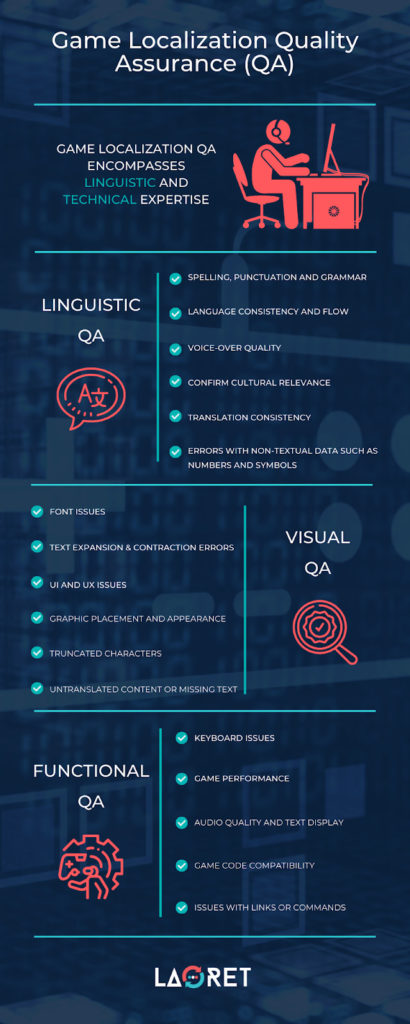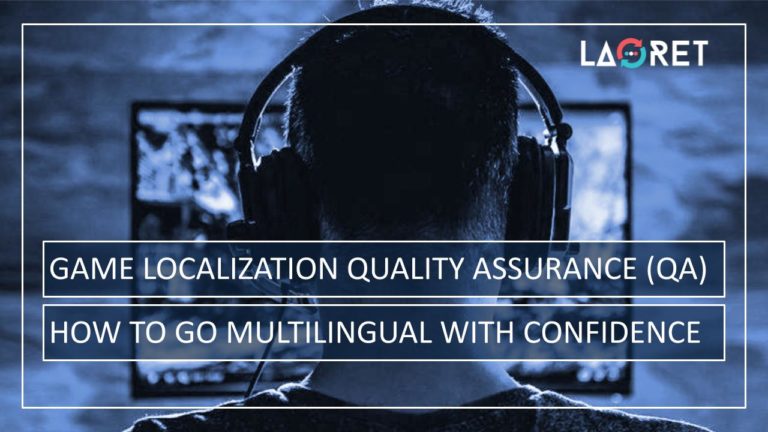Game Localization Quality Assurance (QA): How To Go Multilingual With Confidence
Quality Assurance (QA) & testing is that final, crucial step you need to take before your game can hit the international market. But contrary to popular belief, QA is not just a group of gamers or developers playing a game over and over, but rather a highly specialized stage of the localization process.
Find out what the Game Localization QA Process entails, and also get some insights on what happens on the Language Service Provider (LSP) as well as the client side.
Game Localization In A Nutshell
First things first. Let’s briefly explain what the localization process entails. The Game Localization Process combines translation with a targeted cultural adaptation through the use of specialized localization technology.
In order to achieve this, the game content will go through the Translation, Editing, and Proofreading (TEP) stages. A game usually has three types of content:
- In-Game Content: which basically includes any content the gamer encounters while playing the game.
- Non-String Content: which, as the name suggests, involves all the non-textual information such as numbers, currency, voice-over, dialogues, as well as text that’s embedded in graphics.
- Game App Store Content and Marketing Content: is the often overlooked yet highly crucial content in your cross-border game expansion (and marketing) strategy. Localization for store content involves keyword localization, but also translating and localizing screenshots, game previews, etc.
Besides the linguistic aspect, there’s a huge technical aspect to game localization that comes into play. It spans from
- Preparing the game for translation and localization
- Maintaining usability and functionality
- Re-engineering the translated content into the game
- Running localization QA and testing processes
Pro Tip! This was a very brief intro indeed! But if you need more specifics on how game localization is best applied, check out our blog on the best localization practices for Unity 3D and read all about it!
Game Localization QA and Testing
The localization of a game is only successful when quality is assured. And that is through ensuring that the linguistic, cultural, and technical adaptation of the game is done right while maintaining the integrity of the game.
While the importance of QA and testing is obvious, that it confirms that the product meets quality requirements, in gaming, it has a specific responsibility towards the target gamers.
Gamers, who are always thought of (and describe themselves) as passionate, are unforgiving of game translation and localization mistakes and are quite vocal about them. So besides quality requirements, game localization QA and testing then becomes focused on conforming to the expectations of the users.
For example, back in 2009, the immensely popular first-shooter game Call of Duty Modern Warfare 2 was released in Arabic. As part of the storyline and design, there was a map of Pakistan that featured Arabic content while Pakistan’s Official Languages are English and Urdu.1 A mistake such as speculating rather than planning and researching will put you at risk of losing a large portion of your audience or, at the very least, make you a laughing stock and have you end up in how not to lists.

The Game Localization QA and Testing Process
Now, let’s see how it should be done and get started with a more global overview before diving into some specifics of the Game Localization QA Process. In order to have an efficient and effective QA, the LSP will:
- Start with goal setting. The Project Manager will analyze your goals and needs and prepare a testing plan accordingly.
- Follow-up with a test preparation where the QA testers and specialists receive the brief on the game, any reference materials, style guides, guides on game play (if they can test the game by playing it themselves), the localization kit, and so on.
- Proceed with the actual game testing where the preferred testing method will be applied (more on this below) and the linguistic quality will be assessed. Any visual or functional bugs will also be reported. The QA testers will provide feedback and any possible suggestions to improve the game.
- Apply a crosscheck if the game is available in several languages and note any errors that are repeated in other versions.
- Implement QA after you have had the chance to review the files.

What Does Game Localization QA Test For Specifically?
Games consist of multiple content layers. In order to have a product optimized in a way that truly speaks to your audience, the game will be subjected to an extensive QA process.
When working with a professional LSP, Game LQA (Localization and Testing) and Testing usually involves a blend of human testing, relying on a team of in-country natives with subject-matter expertise, and automated testing. Taking advantage of this powerful combination, Game Localization QA Testing includes:
Linguistic QA
This is where it all starts: the content. In order to achieve full immersion status and ensure that the translated content connects the users with your game, linguistic QA checks for:
- Any errors in grammar, spelling, but also formats, conversions, and more
- Poor and missing translations
- Consistency throughout the translated content
- Contextual accuracy by confirming the use of naturally flowing content with country-specific idioms and phrases (especially if the targeted country has various regions with multiple dialects). Contextual accuracy is also checked to ensure that the translation maintains the integrity of the game’s storyline and characters and makes accurate and consistent use of game’s terminology and references.
- Cultural references and whether they are appropriate
The QA Of Visual And Functional Features
Of course, words are only a part of the experience. This level of QA check will focus on the visual integrity of the game and note any performance issues that undermine the multilingual gaming experience. This includes:
- Resolving any UI or UX issues
- Being mindful of Text Expansion errors. Some languages take up more space than others which can interfere with the design as well as the performance of your game.
- Editing any graphics that may be inappropriately positioned
- Highlighting the sections that have been left untranslated and communicating them to the linguistic team
- Resolving any font issues such as inconsistencies in usage or even fonts that do not fit the language very well
- Testing the overall performance of the game
- Resolving any coding issues
- Being mindful of keyboard issues and misleading commands
- Resolving issues related to corrupted audio, unsynced subtitles, and missing text

Guidelines For More Efficient QA Game Testing
Within the above-mentioned process from the goal setting to the actual QA implementation, there are ways to maximize the QA Testing in a way that boosts efficiency and saves time, and in the long run, also costs. In order to achieve the best possible results, both the client and the LSP are responsible for providing optimal resources and tools. Some of these are:
- Linguists need context in order to understand the full intention and range of a game to make the best judgement on quality. A simple way to provide this is by giving screenshots of the localized UI.
- While the screenshot method is acceptable, it is best to provide the linguists with the actual game to play so they can truly experience the game from the user’s perspective. The developers on the client side should provide the linguists with cheat code so they can move through the game more quickly. This is not only good for the QA phase but will also make the translation stage run more smoothly.
- A tactic that also works for translation and QA both is the addition of notes for the text strings specifically and providing as much contextual information as possible.
- Once the game passes the QA process, it is highly recommended that a third party be assigned the task of reviewing the translation a final time.
- The LSP will leverage Translation (CAT) Tools to streamline the translation and QA processes. These tools will also be essential when applying Continuous Localization. For this, the CAT Tool will leverage a Translation Memory (TM) so all your past translations will be saved, and translation consistency is maintained while saving a pretty penny.
How Many Rounds Of Game Testing Should Be Applied?
When testing a game, both Smoke Tests and Beta Tests are recommended to confirm that everything has been implemented correctly and the game functions maintain the same level of performance when running with the newly added language(s). But we do often get the question how many testing rounds should be applied. That’s why we’d like to stress a few points here!
- Much to some people’s surprise, a QA tester’s job doesn’t just entail playing a game over and over. This is why each game and each QA Testing process will be different, and the testers can determine for themselves how many rounds of tests a game will need to pass the QA process.
- The QA plan designed by an LSP is highly customized. It is adapted to the range of the game, the number of languages, and the number of assets.
- This level of customization allows for a more targeted and accurate testing environment, keeping the number of testing rounds needed to an absolute minimum.
Conclusion
Game localization QA involves various steps from the linguistic, visual, and functional perspective. To achieve the optimal QA process, qualified professionals should be given valuable contextual information, customize a QA plan, and leverage specialized Localization Tools.
Laoret uses native, in-country experts with years of specialized experience in the gaming industry. With our internally developed tools and technologies, we can easily customize the QA process to each project’s unique parameters.






